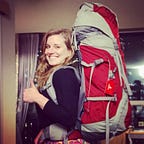Digital Nomad Infographic [Case Study]
Survey
As part of our research for writing The Digital Nomad Survival Guide, my coauthor Peter and I conducted a survey of digital nomads, asking about:
- Demographics: gender, age, education, passport used for travel
- Travel: frequency of movement, programs (like Remote Year), current location
- Remote work: industry, form of employment
- Money: average monthly income, expenses (housing, food, entertainment)
The survey was anonymous — no identifying information was requested.
To get responses, we shared it in digital nomad Facebook groups and with our Remote Year community.
We received over 150 responses, so though it wasn’t a comprehensive census of the entire digital nomad community, it does provide insights to who it is comprised of & answers some common questions people ask about the lifestyle.
[I am working on developing a new survey to capture better data & more responses.]
Design
I took the raw data and used filters & pivot tables to summarize the answers to each question.
Much of the data had to be sorted & summarized individually because people wrote in answers, like specific $ amounts, which were unsortable until I rewrote each one as a readable value (lesson learned).
Then I had to start making design decisions and figuring out the best way to represent the data. This was my first infographic, so I was also learning new ways of using Adobe Illustrator.
I decided to use a designer’s friend icons, vector map, and typography hierarchy from a project we collaborated on as a starting point (Laura Hansen is credited on the infographic & I asked for her approval, of course).
I changed the color palette to a series of bright Pantone colors generated from a swatch I liked, and I made the fonts Lato and Playfair Display to match our website and other materials.
Thanks to Google and YouTube, I learned how to use the graph feature in Illustrator, creating bar graphs and pie charts from my summarized data.
Once I had all the data represented visually, I went back to the section in the book where we discussed it & pulled in some of our insights, rewriting them for the infographic.
As I got the graphs & text laid out, I continued to bring in more color and alternate between white and colored backgrounds to define the sections & make the visuals pop.
After a few check-ins with Peter and a final review by Laura, the infographic was finished!
Peter created a new blank page for me on our website, I uploaded the final file and wrote out some descriptions, added social share and links to other resources on the site, and voila.
Want more information on life as a digital nomad?
I wrote the self-assessment on Digital Nomad Help to help people take the first step in planning life as a digital nomad.
Learn more about the Digital Nomad Survival Guide via my case studies on the writing, editing, cover art, and publishing processes.
Katherine works remotely while she travels the world — on the road since June 2014. Want more? Follow me on Medium and sign up for my mailing list.
If you liked this piece, please give it a ❤ Thank you!
